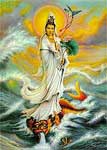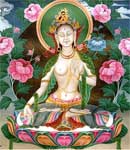Tara worshiped in different traditions. Practical ways of worship

Tara has been worshiped since ancient times, in different cultures around the world. She was revered by the Latins as Goddess Terra, Mother Earth. Druids called the mother goddess Tara. Her name is rooted in the word Tor, which means a “projection of the earth” or “an area laden with spiritual energy” or “connection to the spirit world.” The earliest references to the goddess Tara were found in the ancient epic of Finland five million years ago. The saga speaks of Tar, the Woman of Wisdom. An ancient tribe of indigenous peoples in the jungles of South America called their deity, Tarahumara. Goddess Tara is also associated with Kuan Yin, the great Chinese goddess of compassion. Kuan Yin is that aspect of divinity offering to help the aspirants from a spiritual path that are facing difficulties, guiding them lovingly, with immense compassion. She opens the heart, awakens the state of humility, pure love, and brings harmony, profound knowledge and enlightenment. In Kuan Yin we recognize the divine compassion which manifests itself with infinite grace, full of beauty and wisdom.
Goddess Tara is also associated with Kuan Yin, the great Chinese goddess of compassion. Kuan Yin is that aspect of divinity offering to help the aspirants from a spiritual path that are facing difficulties, guiding them lovingly, with immense compassion. She opens the heart, awakens the state of humility, pure love, and brings harmony, profound knowledge and enlightenment. In Kuan Yin we recognize the divine compassion which manifests itself with infinite grace, full of beauty and wisdom.
 The Cheyenne people talk about the Star Woman who descended from heaven to earth. The plants necessary to feeding started to grow around her. She convinced her people to mate with primitive beings living on earth, bestowing them with the gift of wisdom. This myth is repeated, being present in the writings of Zecharia Sitchin, in which he speaks about the ancient Egyptian goddess Ish Tar which, the legend says, came to earth from another planetary system and advised her people to mate with the inhabitants of the earth making them thus able to do many actions with intelligence.
The Cheyenne people talk about the Star Woman who descended from heaven to earth. The plants necessary to feeding started to grow around her. She convinced her people to mate with primitive beings living on earth, bestowing them with the gift of wisdom. This myth is repeated, being present in the writings of Zecharia Sitchin, in which he speaks about the ancient Egyptian goddess Ish Tar which, the legend says, came to earth from another planetary system and advised her people to mate with the inhabitants of the earth making them thus able to do many actions with intelligence.
Tara is the archetypal female deity in the Hindu mythology, whose name means “star” – known as the Mother Creator in the Indian Hinduism. In ancient Hindu scriptures, she is described as one of the eight major aspects of the Divine Feminine Principle, a loving manifestation compared with the thrilling Kali.
Tara – Tibetan Sgrol-ma, Buddhist Saving Goddess with numerous forms, is largely popular in Nepal, Tibet and Mongolia.
 – Tara is sometimes depicted with eyes on her feet and in her palms. For this reason, she is called Tara with seven eyes, a form of the traditional deity of Mongolia.
– Tara is sometimes depicted with eyes on her feet and in her palms. For this reason, she is called Tara with seven eyes, a form of the traditional deity of Mongolia.
-Adopted by Buddhism and Hinduism, since the third century BC, Tara appears in Buddhism, Jainism, and particularly in Tibetan Lamaism, with a multitude of manifestations: Goddess of asceticism and mysticism, Creative Mother, Protector of the human beings crossing the sea (ocean) of life.
-The legend of Tibet speaks about goddess Tara as the female counterpart of Avalokitesvara Bodhisattva. A legend says that she appeared as a manifestation from a tear of Avalokiteshvara, which fell on the earth and formed a lake. A lotus blossomed at the surface of the lake which, opening, revealed the goddess. Like Avalokiteshvara, she is compassionate, granting her help to the beings that “cross the sea to another shore”. She provides guidance and protection both in the sea and land travel and in the spiritual trips to enlightenment.
-Tara is known in Tibet as the Devoted Goddess, The One that provides full protection. In the mental practice system, offered by the great masters of Tibetan wisdom, Tara is the archetype of our own wisdom. They talk about the transformation of consciousness, a journey to freedom. They teach simple and direct ways for each person to find within themselves the wisdom, compassion and glory ascribed to Tara.
Practical ways of worship
 From the point of view of sadhana or spiritual practice of identification with the giant sphere of power and influence of the Great Powers Cosmic Tara, the most effective way is to practice the technique of laya yoga with the specific mantra of resonance with this magnificent manifestation of God. Another very effective way is the profound meditation, on the subject of invoking the Divine Grace to save and liberate all the beings from the manifestation, i.e. begging the Great Cosmic Power Tara to pour Her endless compassion in the heart of each being of God’s creation. Another way to adore Tara is to place us, at the mental level, at the mysterious interval between two consecutive sounds, to thus fully resonate with the non manifested primordial sound (which is pranava) and to identify with the blissful sphere of consciousness of the Great Cosmic Power Tara. All these ways are safe and effective paths to achieve in a short time (in full accordance with the efforts we are making) the ultimate spiritual liberation (moksha).
From the point of view of sadhana or spiritual practice of identification with the giant sphere of power and influence of the Great Powers Cosmic Tara, the most effective way is to practice the technique of laya yoga with the specific mantra of resonance with this magnificent manifestation of God. Another very effective way is the profound meditation, on the subject of invoking the Divine Grace to save and liberate all the beings from the manifestation, i.e. begging the Great Cosmic Power Tara to pour Her endless compassion in the heart of each being of God’s creation. Another way to adore Tara is to place us, at the mental level, at the mysterious interval between two consecutive sounds, to thus fully resonate with the non manifested primordial sound (which is pranava) and to identify with the blissful sphere of consciousness of the Great Cosmic Power Tara. All these ways are safe and effective paths to achieve in a short time (in full accordance with the efforts we are making) the ultimate spiritual liberation (moksha).
yogaesoteric
November 2012


